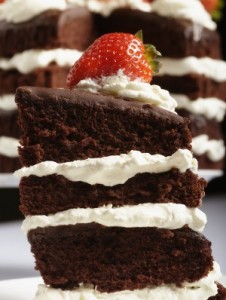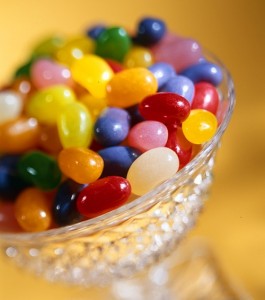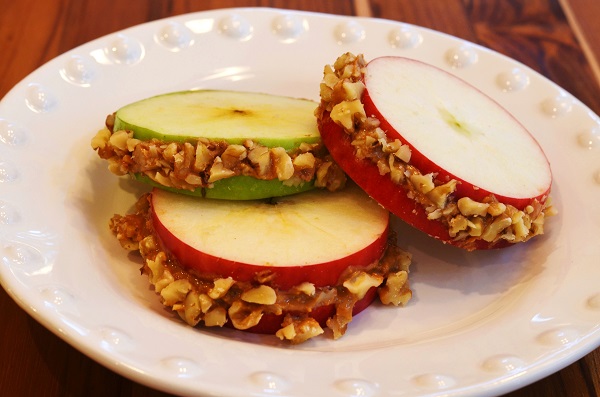For me, the answer is "Yes"! I was born with a sweet tooth. I call it "The Beast".
What I have learned about The Beast over the years is the more sugar I feed it, the more it wants. I used to think, "Hmm, that’s interesting. You would think The Beast would eventually find some level of satiety!" Umm, nope!
As a nutritionist, I manage my calories well for weight maintenance and I love eating loads of nutritious foods but I commonly used sweeter foods as my "discretionary calories", the extra 10 – 20% of the calories in the 80/20 Rule of Eating*.
Recent research, however, has changed my attitude towards sugar. A new documentary called FED UP produced by Katie Couric and Laurie David, featuring prominent family physician Mark Hyman, MD, discusses the addictive quality of sugar. According to Dr. Hyman, the MRI of a brain addicted to sugar looks just like the MRI of a brain addicted to cocaine. Sugar is addictive! Just like other addictive substances, the more you consume, the more it takes to get the same level of satisfaction. We don’t over consume sugar because of a lack of will power, it’s a chemical reaction in our brains driving us to constantly want (need) more.
Wow! That explains The Beast! This was just the kick in the pants I needed to change my relationship with sugar.
* Eat 80 – 90% of your calories from nutrient dense
foods and then have fun with the other 10 – 20% of your calories.
So, How Much Sugar is Too Much?

Research about the link between sugar and diseases like heart disease, diabetes and obesity has lead the World Health Organization (WHO) to propose a new sugar guideline. The proposed WHO Sugar Guidelines, drafted in March 2014, recommend that individuals limit "added sugars" to less than 5% of total calories. That's half of the WHO's previous recommendation from 2002. A final ruling will be released later this year.
How does 5% of total calories translate to grams of sugar?
Calories per Day Max. Grams of Added Sugar per Day
1200 15
1500 19
1800 23
2000 25
2200 28
Here are a few points of reference to put this in perspective:
Food Item Grams of Added Sugar
1 tsp sugar 4
1/2 cup name brand pasta sauce 14
1 oz. M&Ms 18
Deluxe cinnamon roll 36
12-oz. iced mocha,
white chocolate coffee 41
16.9-oz. soft drink 56
16.9 oz. sweet tea 66
Assess Your Relationship with Sugar
Be aware of your personal relationship with sugar. If you look closely at your current daily intake of sugar, you may be surprised (either pleasantly or unpleasantly). Even if your sugar intake is not excessively high, you can likely find ways to decrease sugar and still feel happy. If your sugar intake IS really high, educate yourself about the negative impact sugar can have on your body and become committed to reducing or eliminating sugar from your diet.
Know yourself
Some of my clients recognize the tiniest amount of sugar turns them into the Cookie Monster so they choose to avoid it completely. Other clients have found their sugar threshold, the point at which they can have just a little to avoid feeling deprived but below the point that triggers their Beast.
Take steps to develop your sugar reduction game plan so you can:
- achieve and maintain a healthy weight
- maximize your energy all day
- help prevent conditions that are linked to sugar consumption like heart disease, diabetes, obesity and gut imbalances.
6 Tips for Reducing Sugar in Your Eating Plan
1) Drink unsweetened beverages and plenty of filtered water daily.
2) Nix the fruit juice and eat whole fruit instead. Though fruit juice is natural sugar, it has the same negative impact on your body as processed sugar.
3) Eat lots of fresh, whole foods and less processed foods. (80% of the foods in the supermarket have added sugar.)
4) If you buy processed foods, read labels and choose foods that contain less than or equal to 3 grams of sugar per serving.
5) Choose fruit for dessert. It may sound hard to believe, but fruit becomes amazingly sweet and satisfying when you reduce your sugar intake.
6) Avoid artificial sweeteners because they trick your brain into thinking you are still eating sugar which contributes to the "addiction". If you must add something to make your coffee and tea palatable, add a few drops of honey or pure maple syrup (not pancake syrup) or a small pinch of stevia. Then continue reducing the sweeteners until the "black" version is enjoyable.
NEW Nutrition Facts Label to Include "Added Sugars"
The U.S. Food and Drug Administration (FDA) has proposed a New Nutrition Facts Food Label which will be finalized by the end of this year. One new feature of the proposed food label is Added Sugars listed separately from Total Sugars making it much easier to determine how much sugar has been added to the food. Once the new food label is finalized, foods companies will have two years to implement the changes.
In addition, the Center for Science in the Public Interest (CSPI) has urged the FDA to go a step further and define 25 grams as the Daily Value for Added Sugars and display it on the new food label. This would at quick glance reveal that a 16.9-ounce can of soda is 225% DV.
Apple and Peanut Butter Sandwiches
Source: 31 Delicious Low-Carb Breakfasts for a Healthy New Year
Makes 4 sandwiches
Sink your teeth into your favorite fall apple with this low carb, low sugar breakfast that will provide hours of energy and satiety.
Ingredients:
- 2 medium-sized fresh apples (choose your favorite in season)
- 8 Tbsp natural, no-sugar-added peanut butter (creamy or crunchy)
- 1/3 – 1/2 cup chopped walnuts
Directions:
- With a sharp knife, carefully slice apples across the horizon in 1/3 inch slices. Remove seeds from center slices. Match slices in pairs according to diameter. You should get 2 pairs from each apple (and have a little left over from the top and bottom which you can chop and toss on a salad at lunch.).
- Spread 2 Tbsp. peanut butter across one apple slice. Place the other matching slice on top and press so that peanut butter smashes out the edges. (You may need to add a little more peanut butter depending on the diameter of your apple slices). Repeat with the other 3 pairs.
- Roll the edges of each apple and peanut butter sandwich in chopped walnuts.
Approx. Nutr. Info per Apple Sandwich (using medium apples)
Cal: 299, Prot: 9 gm, Carb: 18 gm, Tot. Sugars (all naturally-occurring sugar) 9 gm, Tot. Fat: 22 gm, Sat. Fat: 2.5 gm, Trans Fat: 0 gm, Chol: 0 mg, Sod: 121 mg
Chef’s tip: If you are preparing these in advance, brush the apple slices with lemon juice and store in an air tight container and the apples will not turn brown.
Click here for a printer-friendly version of this recipe.
Click here for a printer-friendly version of this blog post.




1 Comment
Pingback: 3 Nutrition Tips to Boost Your Energy for Spring - SAS Life